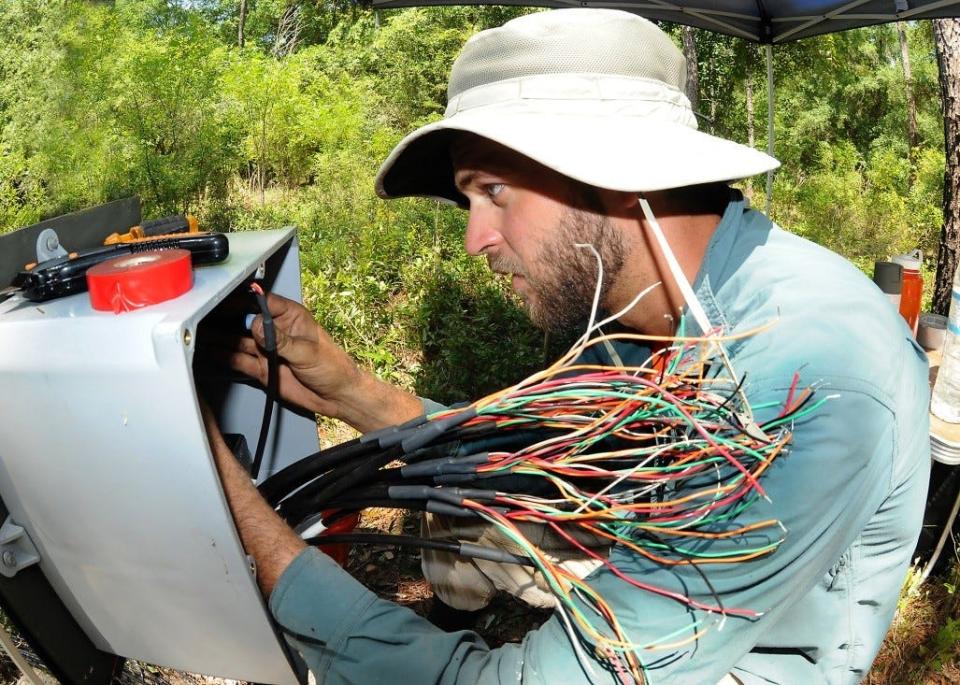Oxygen in the water emerging at Florida's natural springs predicts their health
One in five molecules in Earth’s air is oxygen. We have life itself to thank. Over time, a planetary balancing act of plants and animals and rocks and water has stabilized the oxygen in our atmosphere. No other element so exquisitely reveals the self-regulating wonder of our living planet.
While oxygen exerts influence on all ecological systems, those that lie underwater are especially attuned to its ebbs and flows. For more than a century now, oxygen measurements in water have been central to understanding freshwater ecosystems.
Indeed, G. Evelyn Hutchinson, the father of modern limnology and mentor to the late University of Florida systems ecologist Howard T. Odum, argued in the 1930s that oxygen is the single-most important factor for understanding lakes, rivers, wetlands and aquifers. I’ll add Florida’s springs to the list.

In a series of pioneering scientific papers from the 1950s, Odum developed ideas that transformed ecosystem science, using springs as his living lab. He showed us how to use daily and seasonal rhythms of oxygen variation to measure how aquatic ecosystems “breathe.”
This process, which we call ecosystem metabolism, reveals the dynamic balance between photosynthesis (plants using carbon dioxide and sunlight to grow, releasing oxygen) and respiration (animals and microbes gobbling organic material, releasing carbon dioxide to the atmosphere, and consuming oxygen).
Odum helped us understand that patterns of oxygen variation are, in each aquatic microcosm, a “most beautiful demonstration” that Earth and its biological systems operate as a single entity. Oxygen in water reveals the holistic and dynamic “breathing” of all plants, animals and microbes, mediated by energy from the sun and exchange with the air.

A spring breathes with a daily rhythm of sunrises and sunsets and the sun’s seasonal progression through the sky. This breathing reveals the energy foundation for ecosystem food webs, revealing, for example, that our spring-fed rivers are among the most productive aquatic ecosystems on Earth, rivaling at their summer peak even tropical rainforests.
Like a human pulse, the pulse of oxygen in water also indicates ecosystem health, tracing energy flow through living systems as well as shifts in that energy flow imposed by altered water quality and a changing water cycle.
Oxygen is the centerpiece of aquatic ecosystem health. In lakes and estuaries, oxygen can indicate imbalances arising from too much photosynthesis, which we call eutrophication. In wetlands, naturally low levels of oxygen trace the slow passage of dark, organic-rich waters.
More Messages from the Springs Heartland:
Odum expanded knowledge about springs, ecosystems, wetlands and energy
Keepers of the Springs working to restore springs 'from the ground up'
UF/IFAS uses high-tech methods to improve farming practices affecting springs
In the Floridan aquifer, where water can spend decades between falling as a raindrop and emerging at a spring, oxygen variation is enormous, driving chemical and microbial processes that profoundly alter spring water chemistry.
Oxygen in the water emerging at springs predicts their health. Work in my University of Florida lab and by others at UF reveals that oxygen is the primary factor impacting the health of submerged vegetation. It influences the vitality of herbivores such as snails that help control overabundant algae. It regulates springs’ resilience to chronic disturbances such as pollution and pumping.
Indeed, oxygen is the leading variable to explain why some springs are coated with nuisance algae and others are not, and why many springs look far healthier farther downstream from the spring vent — where oxygen has been replenished naturally from the air.

Oxygen also influences the dynamics of nitrogen, phosphorus, iron and many other elements, creating a gorgeous, complex web of daily and seasonal rhythms across almost every element we can measure. When spring flow is slowed or even reversed by rising blackwater rivers, oxygen dynamics change in ways we are only starting to understand.
Recognizing the central role of oxygen in ecosystem health, we conducted an experiment that added oxygen to Hornsby Spring for over a year using aerators, prompting an astonishing re-flourishing of that degraded ecosystem. Elevating oxygen only slightly, we observed astonishing declines in nuisance algae. Submerged plants grew vigorously.
Effects of oxygen alone were enhanced by adding snails, which graze more algae when not stressed by low oxygen. When we turned the aerators off, impaired conditions at Hornsby Spring rapidly returned. This experiment led us to conclude that a deeper understanding of oxygen in our aquifer, specifically where and why it is so low, is the central knowledge gap for springs restoration.
Life on Earth created the oxygen in the air. Life in the water fundamentally depends on the same delicate balance of making and consuming oxygen.
As we peer into the inner workings of our springs — following in the footsteps of Hutchinson, Odum and others — the lesson is clear: Our springs are living, breathing systems, and oxygen is the beating heart that we need to understand to save them.
Matt Cohen is a professor in the School of Forest, Fisheries and Geomatics Sciences at UF. He is an ecohydrologist, focused on questions at the boundary of water and ecosystem science.
This column is part of The Sun's Messages from the Springs Heartland series. More pieces from the series can be found at bit.ly/springsheartland.
Join the conversation
Letters to the editor present the opinions of readers on news stories and other pieces published by The Sun. Share your opinions by sending a letter to the editor (up to 200 words) to letters@gainesville.com. Letters must include the writer's full name and city of residence. Additional guidelines for submitting letters and longer guest columns can be found at bit.ly/sunopinionguidelines.
Journalism matters. Your support matters.
Get a digital subscription to the Gainesville Sun. Includes must-see content on Gainesville.com and Gatorsports.com, breaking news and updates on all your devices, and access to the eEdition. Visit www.gainesville.com/subscribenow to sign up.
This article originally appeared on The Gainesville Sun: Matt Cohen: Florida's natural springs are living, breathing systems

